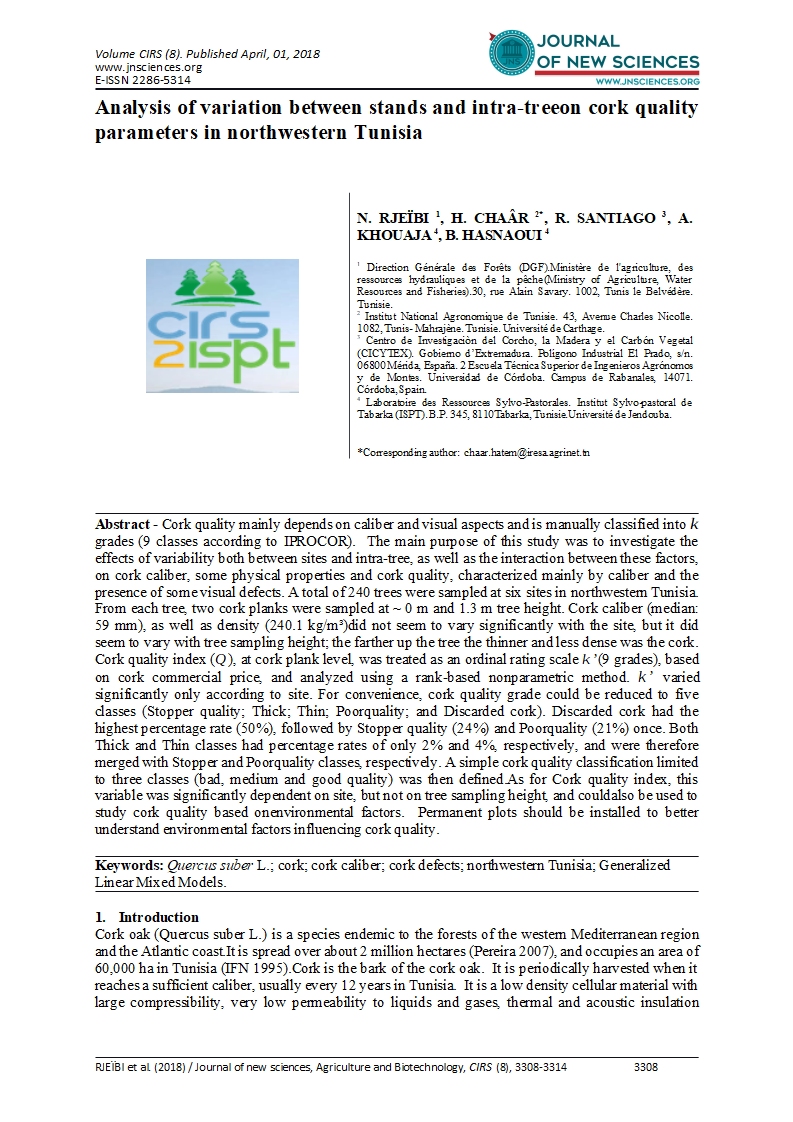

- Category: VOLUME SPÉCIAL (CONFÉRENCE CIRS 2017)
- Hits: 17667
Analysis of variation between stands and intra-treeon cork quality parameters in northwestern Tunisia
|
|
N. RJEÏBI 1 H. CHAÂR 2* R. SANTIAGO 3 A. KHOUAJA 4 B. HASNAOUI 4
1 Direction Générale des Forêts (DGF).Ministère de l'agriculture, des ressources hydrauliques et de la pêche (Ministry of Agriculture, Water Resources and Fisheries).30, rue Alain Savary. 1002, Tunis le Belvédère. Tunisie. 2 Institut National Agronomique de Tunisie. 43, Avenue Charles Nicolle. 1082, Tunis- Mahrajène. Tunisie. Université de Carthage. 3 Centro de Investigaciòn del Corcho, la Madera y el Carbón Vegetal (CICYTEX). Gobierno d’Extremadura. Polígono Industrial El Prado, s/n. 06800 Mérida, España. 2 Escuela Técnica Superior de Ingenieros Agrónomos y de Montes. Universidad de Córdoba. Campus de Rabanales, 14071. Córdoba, Spain. 4 Laboratoire des Ressources Sylvo-Pastorales. Institut Sylvo-pastoral de Tabarka (ISPT). B.P. 345, 8110Tabarka, Tunisie.Université de Jendouba.
|
Abstract - Cork quality mainly depends on caliber and visual aspects and is manually classified into  grades (9 classes according to IPROCOR). The main purpose of this study was to investigate the effects of variability both between sites and intra-tree, as well as the interaction between these factors, on cork caliber, some physical properties and cork quality, characterized mainly by caliber and the presence of some visual defects. A total of 240 trees were sampled at six sites in northwestern Tunisia. From each tree, two cork planks were sampled at ~ 0 m and 1.3 m tree height. Cork caliber (median: 59 mm), as well as density (240.1 kg/m³)did not seem to vary significantly with the site, but it did seem to vary with tree sampling height; the farther up the tree the thinner and less dense was the cork. Cork quality index (
grades (9 classes according to IPROCOR). The main purpose of this study was to investigate the effects of variability both between sites and intra-tree, as well as the interaction between these factors, on cork caliber, some physical properties and cork quality, characterized mainly by caliber and the presence of some visual defects. A total of 240 trees were sampled at six sites in northwestern Tunisia. From each tree, two cork planks were sampled at ~ 0 m and 1.3 m tree height. Cork caliber (median: 59 mm), as well as density (240.1 kg/m³)did not seem to vary significantly with the site, but it did seem to vary with tree sampling height; the farther up the tree the thinner and less dense was the cork. Cork quality index ( ), at cork plank level, was treated as an ordinal rating scale
), at cork plank level, was treated as an ordinal rating scale  (9 grades), based on cork commercial price, and analyzed using a rank-based nonparametric method.
(9 grades), based on cork commercial price, and analyzed using a rank-based nonparametric method.  varied significantly only according to site. For convenience, cork quality grade could be reduced to five classes (Stopper quality; Thick; Thin; Poorquality; and Discarded cork). Discarded cork had the highest percentage rate (50%), followed by Stopper quality (24%) and Poorquality (21%) once. Both Thick and Thin classes had percentage rates of only 2% and 4%, respectively, and were therefore merged with Stopper and Poorquality classes, respectively. A simple cork quality classification limited to three classes (bad, medium and good quality) was then defined.As for Cork quality index, this variable was significantly dependent on site, but not on tree sampling height, and couldalso be used to study cork quality based onenvironmental factors. Permanent plots should be installed to better understand environmental factors influencing cork quality.
varied significantly only according to site. For convenience, cork quality grade could be reduced to five classes (Stopper quality; Thick; Thin; Poorquality; and Discarded cork). Discarded cork had the highest percentage rate (50%), followed by Stopper quality (24%) and Poorquality (21%) once. Both Thick and Thin classes had percentage rates of only 2% and 4%, respectively, and were therefore merged with Stopper and Poorquality classes, respectively. A simple cork quality classification limited to three classes (bad, medium and good quality) was then defined.As for Cork quality index, this variable was significantly dependent on site, but not on tree sampling height, and couldalso be used to study cork quality based onenvironmental factors. Permanent plots should be installed to better understand environmental factors influencing cork quality.
Keywords: Quercus suber L.; cork; cork caliber; cork defects; northwestern Tunisia; Generalized Linear Mixed Models.

